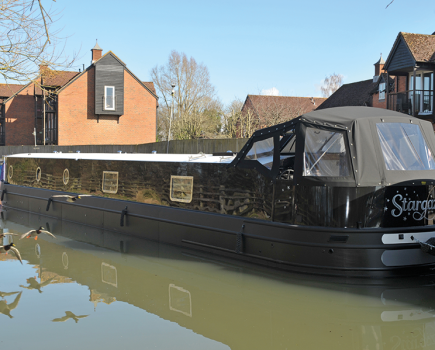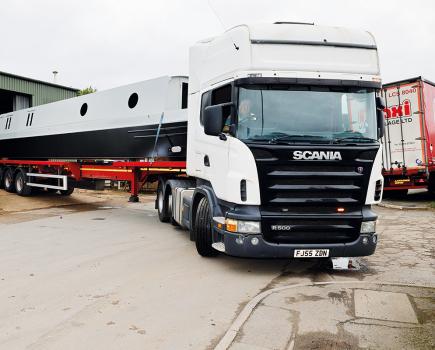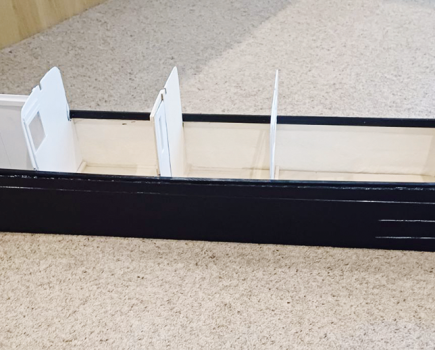Keenly priced ‘standard’ boats don’t have to be basic, and as Alyssa Rose shows you you can pack a whole lot more into a family 57-footer with a bit of compromise and some well thought out ideas and design.

Fitting everything you need into a boat is difficult at the best of times, but it’s even more tricky if you’re on a budget. Every foot you add when you have a boat built costs, and that’s not the end of it; the longer the boat, the higher your licence fee and the more you’ll pay for your mooring.

But Les Robinson reckons he’s come up with a solution: a boat that seems to fit a quart into a pint pot, which seems bigger on the inside than on the outside; an affordable boat with more – much more – inside space than you’d expect but one that will help to keep your costs down, too.

It all comes from having an extended cabin rather than a well deck. “I began with a 50ft boat,” says Les, “and realised that by dispensing with the front deck and using that four or five feet for the cabin, you’d get ten per cent extra space inside.”

So by sacrificing that outside space, everything you’d find in a 57ft boat could be fitted into just 50ft, and the Cygnet model was born. It was followed by the Desire, a similar boat but with a higher spec. And now there’s this boat, the Dynasty, designed for a family, and which manages to fit into just 57ft all the accommodation you’d find in something around the 62ft mark.

If that wasn’t enough, then there’s the price – we like well-priced boats and the 50-footers start at £60,000 and a boat like Alyssa Rose is just £73,000 for 57ft. Not a bad start, but how does the idea shape up?


LAYOUT AND FIT-OUT
One of the reasons the price can be so low is the way the boats are built: as suggested by the firm’s name, the designs are standard. The basic layout is the same and so is the equipment, but there can be some variations internally, such as worktops.
The extended cabin and the layout are the key features of this boat – and the two work together hand in hand. There are no doors at the bow, making the front of the boat a dead end, so that’s where the main bedroom is, with room for a king-size bed. The shower room is behind. “It means the bedroom is completely private,” says Les, “because no-one has to walk through it. And the shower room is like having an en suite.”
Next comes the family-friendly element of the boat, a second bedroom which, in this case, contains two bunks. Then there’s the saloon and dinette, followed by the galley at the rear, with steps leading up to the cruiser stern deck. Les Robinson believes it’s the ideal layout and it certainly works for the owners of Alyssa Rose, Adrian and Christine Wood. “We often have our granddaughters on board with us, and they love the boat,” says Adrian.
The fit-out uses ash-faced panels to give a light, airy feel. It has to be said that the fit-out is fairly simple – but it’s effective and this is a budget boat, and you wouldn’t expect the finest joinery and carving at this price. Even so, the materials are decent quality, and there’s attractive engineered oak flooring in the living areas, with nice stone tiles in the galley and shower room.
EXTERIOR
The shell for this boat comes from Stourport Canal Craft, a relatively new company (they began in 2011), although the staff have plenty of experience at working with steel and building narrowboats. This 57ft cruiser has a substantial steel rail round the rear deck and there are nice touches such as a finger-grip along the handrail, and a grab handle in the forward cabin edge to make it easier to step on to the small front deck. The steelwork also looks good, with nice smooth cabin sides and crisp corners.
The bow shape is quite pointed without any curves – but it’s like that for a reason. Martyn Jones from Stourport Canal Craft says they came up with the shape because of the need to fit the king-size bed at the bow. “The footprint at that point can’t be narrowed at all,” he says, “so the bow ends up rather more bluff than we’d usually build. It’s all built around the accommodation.”
An extended cabin can look a bit clumsy, but the team at Stourport have done a good job in making it look part of the boat, with curves which follow the gunwales. It’s helped by the fact that the foredeck is still a decent size, so the front of the boat doesn’t look too stubby. There’s a gas locker in the bow, which includes a gas leak detector. The stainless steel water tank is positioned behind and extends under the bed. All the trim, such as the mushroom vents, are chrome and there are fold-out steps to ease getting up on the roof; navigation lights are fitted as standard. The windows are units from Worcester. The boats are painted in-house at Standard, and they’re finished to a high standard, too.
GALLEY
There is only one proper entry point to the boat, so we’ll start our tour there, at the stern. Three steps lead down from the rear deck and all have lifting treads for storage. Alongside there’s the electrical cupboard, and plenty of other storage.
The galley units are bought in from a big name DIY store and, as such, come with a choice of finishes. They have Formica worktops and a stainless steel sink. There’s certainly no shortage of storage space. Equipment includes a 240-volt fridge freezer, and a Stoves 500DIT slot-in cooker which has a lifting glass lid over the hob.
DINETTE AND SALOON
The L-shaped dinette has attractively upholstered cushions, and hides a mass of storage – 16 cubic feet, to be precise. It also converts easily into a guest double bed, with the whole base pulling out. The table has folding legs, so you can take it outside and use it on the towpath if you wish. It stores under the gunwales. There are side doors on both sides of the boat and all the windows are fitted with roller blinds.
The saloon is left open-plan for freestanding furniture. It does, though, include a flat-screen TV mounted on the forward bulkhead with a signal booster so you’ve got more chance of getting a picture. Another standard piece of kit (which comes as something of a surprise in a boat in this price bracket) is a Wi-Fi router.
The Teltonika RUT500 is connected to an antenna on the roof and takes a mobile broadband sim card. It means you shouldn’t have to have a mobile dongle hanging out the window, or exposed on the roof. “Of course, you still need a decent signal,” says Les, “but we think that fitting equipment like this shows a more professional approach. It also seems to be an essential requirement for anyone who has children on board.”
SECOND BEDROOM
A corridor on one side of the boat leads past the bunk room, which is accessed by a sliding door; it’s really more like a partition than a door. Each bunk has its own cupboard and reading light, and the room also has plenty of shelves. There’s longer-term storage under the lower bunk. It’s a room that has received a big thumbs up from Adrian Wood’s granddaughters, who are aged ten and 12 – and the beds are plenty wide enough that they should still enjoy their boating for many years to come.
In a sign of the flexibility available, this room can be specified with a single bed rather than bunks if you’re more likely to use it as a guest room than a kids’ room. One buyer even asked for the room to be left out completely to make the saloon bigger.
SHOWER ROOM
The walk-through shower room feels spacious. There’s an 800mm quadrant shower which is fully tiled; alongside it a removable panel provides access to the plumbing. The toilet is a Thetford flushing cassette (although other options are available) while the basin sits on a corner unit with a cupboard underneath. There’s also a heated towel rail.
CABIN
The star of the main cabin is undoubtedly the king size bed, which is a full 6ft 6in long, by 5ft wide. It’s a feature that Adrian Wood is particularly keen on. “Someone of my height needs a bed this size,” he says. “I couldn’t cope with a cross bed, or one with bulkheads at both ends, I just don’t fit into them”. While some of the space under the bed is taken up by the water tank (the water pump is under here too, which is not ideal if you want to fill the kettle for an early morning cuppa without waking up your other half), there’s also storage space.
Cupboard room is plentiful with a large wardrobe offering shelves and hanging rails, and there’s a dressing table alongside. The window at the head of the bed opens, and the glass can be lifted out completely.
TECHNICAL
Looking at the list of technical equipment, you’d think it came from a much more expensive boat.
The engine is a Vetus 4.17, that produces 42hp and will be powerful enough for a boat of this size. The running gear is also by Vetus and includes a water-lubricated stern tube that doesn’t need daily greasing. Plus, the engine is fitted with twin alternators.
Access to the engine hole couldn’t be easier. The deck boards lift off completely, as does the metal framework underneath, so maintenance jobs should be easy.
There are four 110Ah domestic batteries, plus a 96Ah for the starter. Alyssa Rose has a Sterling 2.5kW combi inverter giving a 240-volt supply (which is an upgrade from the standard 1.8kW model usually fitted). Another option is an upgrade to a full Mastervolt digital system – although this preference would add around £5,000 to the price of the boat. There’s a shorepower point at the stern.
There is LED lighting throughout to reduce power consumption and the electrics run down the centre of the ceiling; they can be accessed through a removable panel.
In a very forward-looking move, Standard have fitted a solar panel connection on the roof. It means that, if you were to decide to have panels installed, the wiring is already in place and you wouldn’t need to drill a hole in the roof. It would just be a matter of connecting up the panels at one end and the controller at the other.
Heating is provided by a Webasto 4kW diesel boiler. There are multiple ways of getting hot water because the calorifier is heated by the engine, the Webasto, and a 1kW immersion heater.
Standard include a year’s River Canal Rescue membership with all their boats.
ON THE WATER
The cruiser stern deck is large and roomy, so you can have plenty of people with you at the helm, and it makes the ideal outside space when you’re moored up.
The shell makes commendably little wash when underway – even with its rather bluff front end. The engine is smooth and quiet (and if you wanted to make it even quieter, it would be very easy to add some sound insulation under the deck boards). The steering is light (probably due in part to quite a long tiller) and the boat responds well; it turns very easily, as we found when we winded at the halfway point in our test.
In common with many cruiser-sterned boats, the Morse control is on a column to one side, and is a little low down. It also seems quite a long way away if you’ve got the tiller hard over the other way.
CONCLUSION
It’s clear that, if you’re into traditional looking boats, this one might not appeal (but, to be honest, you probably wouldn’t consider a cruiser stern of any type). But there’s no doubt that this is a lot of boat for the money.
Les Robinson’s idea of extending the cabin means you can get a boat with far more accommodation than you thought you could afford; to fit two bedrooms into a 57ft boat and yet still have a spacious saloon and galley is quite remarkable.
The other surprising thing is what you get for your money – because these boats have a very high specification.
“We wanted to make sure our buyers have everything they need, right from day one,” says Les. “I don’t believe you should have to spend more money on things like ropes and fenders, so we include all those sort of things.” And that’s on top of a decent shell, a reliable engine, and good quality electrics.
Economy is where this boat really wins. And if you thought you couldn’t afford the size of boat you wanted, perhaps this boat will prove you wrong.
Image(s) provided by:
Archant







